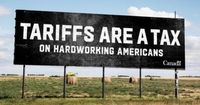As Canada navigates an increasingly tumultuous economic landscape, a recent report from BofA Securities, spearheaded by economist Carlos Capistran, projects a downward revision in the nation's GDP growth. This forecast suggests a growth rate of just 1.5% for 2025, a notable drop from the previously expected 2.4%. Additionally, GDP growth estimates have been adjusted to 2.0% for 2026, down from 2.2%. As the nation prepares for impending elections and a potential trade war with the United States, these figures come under a cloud of uncertainty.
On March 21, 2025, Capistran underscored the necessity for a prime minister elected through a federal election to spearhead a renegotiation of the United States-Mexico-Canada Agreement (USMCA). This point is especially salient given that the country faces a crucial federal election, anticipated to take place by October 20, 2025. There are whispers, however, that Prime Minister Mark Carney—already in the hot seat—may call for snap elections as soon as March 23, 2025, with a projected voting day of April 28.
The looming election is shaping up to be quite competitive. With Pierre Poilievre, leader of the Conservative Party, poised as a formidable challenger, the potential for significant shifts in the political spectrum adds another layer of complexity to Canada's economic forecast. Capistran points to upcoming negotiations concerning USMCA as essential for maintaining robust trade relations with U.S. partners, especially as tensions persist.
Despite the ongoing adversities, Capistran’s report predicts a drop in the USD/CAD exchange rate to 1.40 this year. This projection is tethered to expectations of trade war de-escalation, yet refers to the backdrop of tariffs imposed by U.S. President Donald Trump. The economist hinted at potential fiscal expansion regardless of the election outcome, suggesting efforts to bolster the economy amid a burgeoning trade war.
Canada’s response to the incessant barrage of tariffs from the U.S. has shown an escalating strategy. Foreign Affairs Minister Melanie Joly recently announced bold plans to erect a series of billboards in twelve “red states” across the U.S.—including Florida, Nevada, and Michigan—to incite public dissent against the perceived harms of American tariffs. “We need to send a message to the American people for them to understand what’s at stake,” Joly urged during her latest interview with CNN. She described American citizens as the “first victims” of Trump’s tariff policies.
In the midst of this trade war, the stakes are incredibly high. Trump has outlined plans to impose reciprocal tariffs against Canada and other nations on April 2, creating urgency around Canada’s countermeasures. Since February 1, when tariffs of 25% were levied against Canadian imports—excluding energy and potash—the situation has only escalated. Following a brief delay by Trump, Canada responded with its own set of counter-tariffs scheduled to take effect on March 4.
Despite the haggling and political maneuvering, both nations appear poised for direct confrontation. The pressure of this trade war, which has already led to Canada imposing tariffs on approximately $60 billion worth of American goods, underscores the gravity of the upcoming election cycle. Joly, communicating directly with the American public, urged dialogue with their elected officials. “Please, talk to your senators, talk to your House representatives,” she implored constituents across the border.
While tensions mount ahead of April 2, Joly has expressed that delays to tariffs have been made out of “good will.” Yet Canada is prepared to unleash its second-round of levies targeting a staggering $125 billion in American goods should the trade front not abate. With high stakes at play, Prime Minister Carney has emphasized the need for measured responses, recognizing the imbalance in economic scales. “There is a limit... to how Canada can respond,” he noted, shedding light on the complexities of proportional retaliation.
These unfolding dynamics reflect a larger confrontation over trade policy, marked by threats, reversals, and executive orders. In early March, following the imposition of tariffs on Canadian steel and aluminum, the U.S. had also paused added taxes on goods covered by CUSMA—a lifeline that currently covers over 98 percent of Canada’s exports to the U.S.
The volatile interaction between Canadian and U.S. politicians emphasizes the interconnections of civic action and governmental response during heightened periods of tension. Prime Minister Carney and Canadian lawmakers have further leveraged media appearances to engage with American audiences, striving to shift public sentiment to their favor. As Carney remarked, “We are not going to take an action that we think is not ultimately going to influence the United States.”
These developments in the Canada-U.S. trade war showcase the fragile balance between domestic political markets and international economic relations. As the April deadline approaches, the political climate in Ottawa and Washington will set the stage for the economic landscape in North America. Wielding billboards and potent messaging, Canada is preparing for a multifaceted campaign—one that could have lasting impacts on trade relations and political fortunes for years to come.




